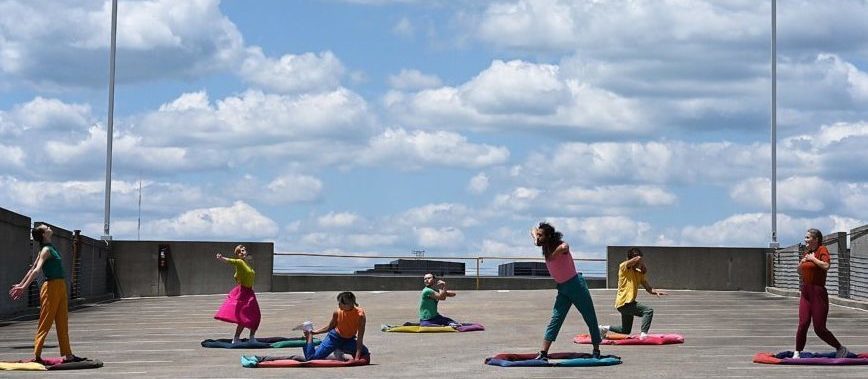Jana Harper: Creating performance art during COVID-19
THE WORK
“What are the burdens we carry?”
For three years, Associate Professor of the Practice of Art Jana Harper has been exploring and answering that question through her project This Holding. “That question multiplied into other questions,” Harper said. “What might those burdens look like? What do they look like for us as individuals? What do they look like for us in partnership? What do they look like in our families, in our communities? It was just this idea of how we carry what we carry.”
Part of her work has involved creating sculptural objects to represent the burdens that we carry across the arc of our lives. Soft, colorful, and weighted, her sculptures are meant to be held. But the significance of those sculptures is as individual as the person holding them. Through workshops Harper has hosted across the U.S., she has explored the multitudes of human experience that her sculptures represent and the empathy they engender. Harper has found many answers to her original questions—answers that underscore the connections that bind us all together.

“In the course of researching this work, I have talked to hundreds of people in dozens of workshops: doctors, dancers, middle-school kids, college students, retirees, folks from many different countries, and from all walks of life. I always start by asking them to name the burdens they carry and together we make a list,” Harper wrote about the project. “To be sure, each group has specific weights they bear, but in the end, we share the same fundamental human concerns: we worry about our loved ones, our futures, our planet, and of course, our health.”
After years of exploring and creating art around her original idea, Harper gained a burst of momentum last year when the National Endowment for the Arts awarded OZ Arts Nashville, a contemporary performance & installation space, a grant to support a live production of This Holding. The partnership with OZ Arts allowed Harper and her collaborators—choreographer Rebecca Steinberg and musician Moksha Sommer— synthesize the research from Harper’s workshops and create a multi-disciplinary live performance. The performance would showcase Harper’s sculptural objects, the movement and gestures of dancers from contemporary dance company New Dialect, live music composed by Sommer, and a cast from the community workshops Harper held.
But as production got underway, the first cases of COVID-19 appeared in Nashville.
THE SHIFT
A few weeks ago, standing at the top of a parking garage in Nashville, a group of dancers stood six feet apart, creating a striking scene of bright pinks, blues, oranges, and yellows dotted against a vivid blue sky. They had just finished their last performance for This Holding. The location—and the distance between the performers— was the result of the massive shift Harper and her team had to make after COVID-19 halted their live production in its tracks.
Once the virus hit Nashville in March, the dancers could no longer meet together in their rehearsal space, OZ Arts could no longer fill its warehouse with a live audience, Harper could no longer hold community workshops, and the project seemed on the verge of postponement or cancellation. But, quick to pivot and keep the project alive, Harper suggested the production switch from a live performance to a film. With the health and safety of dancers and collaborators at the forefront, the team began to reimagine their project. Social distancing guidelines were incorporated. Only dancers who had been quarantined together performed duets together. Group performances kept six feet between dancers. The vision evolved. Then they brought in videographer and Vanderbilt alumnus Sam Boyette to help transfer their ideas to the screen. In two months, they condensed three years of work into a 30-minute film.
“We were all pretty nervous before shooting that first scene,” Harper said. “Perhaps because as an artist I’m not tied to one discipline and because all of my collaborators are so nimble, we were able to pivot relatively easily and quickly, which ended up being really important.”
THE FILM
The resulting film is everything Harper intended This Holding to be, and more. This new dynamic—the influence of the pandemic on the project—also resulted in a name change. The new iteration of Harper’s work is now This Holding: Traces of Contact. Harper said the change refers to their memory of the work—the memory of when they could touch each other, when they could rehearse indoors, when they could do a lot of things they can’t do now. Those are the traces. Of course, the new title also alludes to contact tracing—an intentional reference to the impact of the virus on the performances. The physical and emotional tolls of the pandemic are woven into the performances. They are burdens the performers carry throughout the film.

The online premiere of the project was held May 29, the same day the live performance was meant to premier at OZ Arts Nashville. Broken up into sections I-VII, the film never veers from its original intention of understanding our burdens. Throughout the piece, dancers carry, wear, are wrapped in, struggle with, embrace, let go of, and dance in Harper’s soft sculptural objects. But now environment, time of day, and landscape also play a role in the narrative of the piece. Movement and stillness, touch and breath, light and dark, sound and silence—each element showcases the depth and breadth of Harper’s work. The dichotomy of isolation and intimacy on display in the film also carries added weight in the midst of the pandemic.
Harper is hopeful that this piece of performance art can act as a balm for viewers. “My biggest hope is that people will see themselves in this work,” Harper said, “and that they—especially at this moment in time—will feel less alone.”
Harper’s project is viewable for free online through the month of June on the OZ Arts Nashville website.
